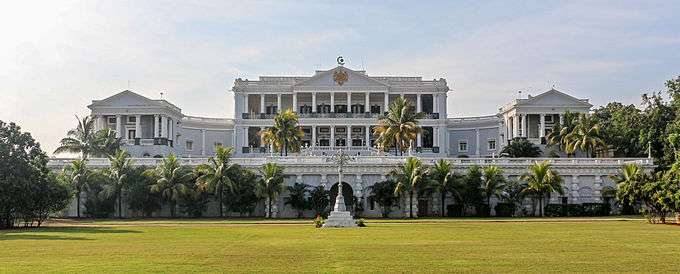Paigah family
| Paigah پایگاه | |
|---|---|
| Noble family | |
| Country | Hyderabad State |
| Connected families | Asaf Jahi dynasty |
| Dissolution | 1948 |
Paigah is a family in the senior aristocracy of Hyderabad State and each maintained his own court, individual palaces, and a standing army of three or four thousand soldiers.
Sir Vicar-ul-Umra, a Paigah nobleman who also served as the Prime Minister of Hyderabad presented the Falaknuma palace to the sixth Nizam, Mir Mahbub Ali Khan, in 1897-98, as Nazar (offering).
History
The word Paigah, which means pomp and rank in Persian, was a title given by the second Nizam of Hyderabad to Nawab Abul Fateh Taig Jung Bahadur in appreciation of the royal services rendered by him. The Nawab was also conferred with the title of Shams-ul-Umra, and he became the founder of the Paigah family.[1][2]
After Abul Fateh's death in 1791, his son Fakhruddin Khan inherited the estates and titles. He was given the title Amir-e-Kabir, which meant Head of the Nobles. He also married the daughter of Asaf Jah II, Sahebzadi Bashirunissa Begum in 1797. Thus began the tradition of marrying the Nizam's daughters to young men of the Paigah family.
Fakhruddin Khan's grandson through his third son was Sir Asman Jah. Fakhruddin Khan's fourth son Rasheeduddin Khan had two sons, Viqar-ul-Umra and Khurshid Jah.[2]
Bashir Yar Jung, a grandson of Viqar-ul-Umra married Saleha Sultan, the daughter of Sajida Sultan and Iftikhar Ali Khan Pataudi. Their son Saad Bin Jung is a member of the Paigah family as well as Pataudi Royal Family.
Family tree
- Nawab Abul Fateh Khan Tegh Jung, Shams ul Umra I
- Shams ul Umra II, Amir e Kabir I, Nawab ‘Abu’l Fakhr Muhammad Fakhr ud-din Khan Bahadur (served as Prime Minister of Hyderabad)
- Sahibzada Muhammad Farid ud-din Khan
- Shams ul Umra III, Amir e Kabir II, Nawab Rafi ud-din Khan Bahadur
- Asman Jah, Amir e Akbar, Nawab Sir Muhammad Mazhar ud-din Khan Bahadur (served as Prime Minister of Hyderabad)
- Amir-i-Paigah-i-Asman Jahi, Muin ud-Daula, Nawab Muhammad Muin ud-din Khan Bahadur
- Muhtasham ud-Daula, Nawab Muhammad Wazir ud-din Khan Bahadur
- Asman Jah, Amir e Akbar, Nawab Sir Muhammad Mazhar ud-din Khan Bahadur (served as Prime Minister of Hyderabad)
- Bashir ul-Mulk, Muhtasham ud-Daula, Nawab Muhammad Sultan ud-din Khan Bahadur
- Shams ul Umra IV, Amir e Kabir III, Viqar ul Umra I, Nawab Muhammad Rashid ud-din Khan Bahadur
- Khurshid Jah, Shams ul Umra V, Amir e Kabir IV, Amir e Paigah, Nawab Sir Muhammad Muhi ud-din Khan Bahadur
- Viqar ul Umra II, Amir e Paigah, Nawab Sir Muhammad Fazl ud-din Khan Bahadur (served as Prime Minister of Hyderabad)
- Wali ud-Daula, Nawab Wali ud-din Khan Bahadur (served as Prime Minister of Hyderabad)
- Nawab Muhammad Bashir ud-din Khan Bahadur, Bashir Yar Jung
- Wali ud-Daula, Nawab Wali ud-din Khan Bahadur (served as Prime Minister of Hyderabad)
- Shams ul Umra II, Amir e Kabir I, Nawab ‘Abu’l Fakhr Muhammad Fakhr ud-din Khan Bahadur (served as Prime Minister of Hyderabad)
Note: The family tree only covers some notable members. There are hundreds of members
Relationship with the Nizams
The bond between the Nizams and the Paigah nobility strengthened with the marriage of Abul Fatah Khan’s son Fakhruddin Khan with the daughter of Mir Nizam Ali Khan, Asaf Jah II, Sahebzadi Bashirunissa Begum in 1797. Henceforth, Fakhruddin Khan’s descendants married daughters of other Nizams and consequently, in protocol, the Paigah's were considered next only to the Nizams. The Paigah jagir was the largest in the state, second only to the Nizam.
The Paigah nobility, being sons-in-law and brothers-in-law to the Nizams, were to a certain extent above the law. The local police and courts did not have personal or in rem jurisdiction over their persons or property. They were subject only to the jurisdiction of the Nizam.

Tombs
The Paigah Tombs are the tombs belonging to the nobility of Paigah family. They were constructed over a period of time during the 18th, 19th and 20th centuries. They are located at the Santoshnagar locality of Hyderabad. The tombs are made out of lime and mortar with beautiful inlaid marble carvings.[4]
Paigah Deodis
The Paigah noblemen were known for their residences, usually known as Devdis.[5]
Bashir Bagh Palace belonged to Sir Asman Jah, a Paigah Amir (noble) and Prime Minister of Hyderabad (1887–1893).
Sir Vicar-ul-Umra, the Paigah Amir (noble) and the then prime minister of Hyderabad state 1894–1901 (also officiated as prime minister in 1893) presented Falaknuma palace in 1897, easily one of the most opulent palaces in the country to the sixth Nizam, Mir Mahbub Ali Khan.

Other important Paigah Palaces were:
See also
References
- ↑ Safvi, Rana (2018-01-21). "The Paigah's necropolis". The Hindu. ISSN 0971-751X. Retrieved 2018-07-22.
- 1 2 Lynton, Harriet Ronken; Rajan, Mohini (1974). The Days of the Beloved. University of California Press. ISBN 9780520024427.
- ↑ https://www.thehindu.com/todays-paper/tp-features/tp-metroplus/saads-jung/article3894869.ece
- ↑ Sripada, Krishna (2017-07-13). "The Paigah Tombs: The lime and mortar wonders". The Hindu. ISSN 0971-751X. Retrieved 2018-08-23.
- ↑ "Forgotten Heritage: The Devdis of Hyderabad - Go UNESCO | GoUNESCO". www.gounesco.com. Retrieved 2018-08-05.
- ↑ "Devdi Khurshid Jah in a state of dilapidation | The Siasat Daily". archive.siasat.com. Retrieved 2018-07-22.
- ↑ Khan, Asif Yar (2014-07-16). "Khursheed Jah Devdi cries for attention". The Hindu. ISSN 0971-751X. Retrieved 2018-07-22.
- ↑ "The Hindu : Palace with a view". www.thehindu.com. Retrieved 2018-07-22.
